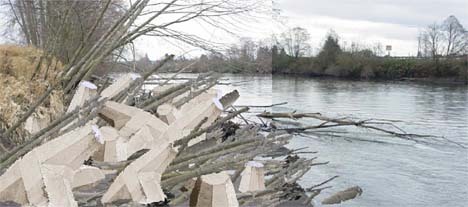Pierce County Public Works and Utilities is set to begin 30 days of construction on a Puyallup River levee stabilization project on July 27. The project will reinforce the levee for better flood protection using an innovative, fish-friendly shoreline stabilization technique.
Sport fishing season on the Puyallup begins Aug. 16 and may overlap the construction project for up to two weeks. According to Pierce County officials, the project is timed to comply with environmental permit requirements aimed at protecting juvenile salmon as they migrate from the river to the ocean. The river flow is at its lowest level this time of year, and most juveniles, called smolts, have already migrated to salt water.
Some salmon, both juveniles and adults, are always present in the Puyallup River, making it impossible to build the project at a time when there are no fish in the system. This year, adult salmon — and lots of them — will be returning to the river during the construction window.
“We are anticipating a huge season for pink salmon,” said county fish biologist Tom Nelson. “Depending on weather and other factors, anywhere from 10,000 to 20,000 fish could pass through here every day.” The construction permit includes a requirement to shoo curious fish away from the work zone, but most salmon are expected to avoid the area due to the construction activity.
Pierce County civil engineer Hans Hunger explained the need for urgency on this project. “The silt bench at this location acts as the first line of defense against levee erosion caused by the river,” he said. “Our observations show that the erosion is erratic and unpredictable, and we can’t say for certain that the next flood won’t cause the levee to fail in this spot. This is the best time to stabilize it.”
When the project is completed, a matrix of large concrete blocks and logs will trap sediment and counter the erosion that threatens the levee, as well as provide excellent fish habitat and a good place for fishermen to find holding fish.
The project will use cast concrete blocks called dolosse and a natural log matrix to protect about 200 linear feet of eroding bank. A dolos is an eight-ton, eight-foot-high cast concrete object with a distinctive knobby shape. The unique design causes them to interlock when subjected to wave action and other forces of nature, allowing them to be used worldwide to protect harbors, beaches and seawalls. Unlike concrete blocks with straight, flat sides, dolosse can not be swept away by swift currents and pounding storms.
Other erosion control strategies were explored by county engineers, but they exceeded budget and time requirements. Re-rocking the silt bench at the base of the levee would require de-watering a work zone within the river, costing about $3 million to complete and resulting in greater environmental impact. The dolos and log approach is estimated to cost less than $500,000, enabling the county to save money while stabilizing the levee and still being fish-friendly.
The project, which received permits from the Puyallup Tribe of Indians and the City of Fife, calls for 66 dolosse to be set. Once in place, they are designed to self settle, locking into a permanent position that will trap natural sediment and river debris, offsetting the erosion that currently affects this location. Logs will be embedded with the dolosse to promote sediment accumulation and enhance fish habitat and the natural appearance of the project. Eventually, the dolosse will be mostly hidden by the buildup of sediment and vegetation.
The county purchased the dolosse from Bellingham Marine Industries. Contractor Richard Phillips Marine will precisely install the dolosse at an average rate of six per day in order to complete the project within the permitted timeframe.
The effectiveness of this technique will be closely monitored at the site over the next several years. The county has no plans for additional use of dolosse.
Updates on the project can be found online at piercecountywa.org/siltbench.







